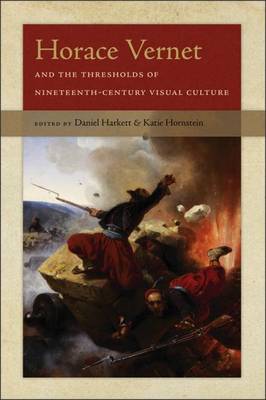
Stock image for illustration purposes only - book cover, edition or condition may vary.
Horace Vernet and the Thresholds of Nineteenth-Century Visual Culture
Daniel Harkett
€ 62.34
FREE Delivery in Ireland
Description for Horace Vernet and the Thresholds of Nineteenth-Century Visual Culture
Paperback. A fresh look at a pivotal nineteenth-century painter Editor(s): Harkett, Daniel; Hornstein, Katie. Num Pages: 280 pages, 40 illus. BIC Classification: ACV; AGB. Category: (P) Professional & Vocational. .
This collection reconsiders the life and work of Emile Jean-Horace Vernet (1789-1863), presenting him as a crucial figure for understanding the visual culture of modernity. The book includes work by senior and emerging scholars, showing that Vernet was a multifaceted artist who moved with ease across the thresholds of genre and media to cultivate an image of himself as the embodiment of modern France. In tune with his times, skilled at using modern technologies of visual reproduction to advance his reputation, Vernet appealed to patrons from across the political spectrum and made works that nineteenth-century audiences adored. Even Baudelaire, who reviled Vernet and his art and whose judgment has played a significant role in consigning Vernet to art-historical obscurity, acknowledged that the artist was the most complete representative of his age. For those with an interest in the intersection of art and modern media, politics, imperialism, and fashion, the essays in this volume offer a rich reward.
Product Details
Publisher
University Press of New England
Format
Paperback
Publication date
2017
Condition
New
Weight
28g
Number of Pages
280
Place of Publication
Hanover, United States
ISBN
9781512600421
SKU
V9781512600421
Shipping Time
Usually ships in 7 to 11 working days
Ref
99-13
About Daniel Harkett
DANIEL HARKETT is an associate professor of history of art and visual culture at Rhode Island School of Design. KATIE HORNSTEIN is an assistant professor of art history at Dartmouth College.
Reviews for Horace Vernet and the Thresholds of Nineteenth-Century Visual Culture
Vernet is now experiencing something of a comeback among art historians, as this excellent volume testifies. A major part of its success is due to its tripartite organization, which crosses thresholds . . . between the public image of Vernet, the artist's attempts to unseat history painting in favor of genre and less antiquated subject matter, and his creative engagement with modern visual technologies. This broad approach, involving essays by well-established specialists as well as early-career researchers, reveals the complexity of the issues at stake.
Nineteenth-Century French Studies Vernet needs - indeed deserves - the wide-ranging reassessment that Horace Vernet and the Thresholds of Nineteenth-Century Visual Culture provides.
Burlington Magazine The contributors to the volume are an impressive collection of well-established scholars and newer voices in the field, giving the work in its entirety a refreshing energy to complement its impressive depth and breadth. Singly and collectively, these articles make a strong case for considering Horace Vernet another worthy candidate for the title of 'le peintre de la vie moderne', Baudelaire notwithstanding. Beautifully conceived and generously illustrated, this is a must-read text for anyone interested in the politics of art and culture in nineteenth-century France.
French Studies
Nineteenth-Century French Studies Vernet needs - indeed deserves - the wide-ranging reassessment that Horace Vernet and the Thresholds of Nineteenth-Century Visual Culture provides.
Burlington Magazine The contributors to the volume are an impressive collection of well-established scholars and newer voices in the field, giving the work in its entirety a refreshing energy to complement its impressive depth and breadth. Singly and collectively, these articles make a strong case for considering Horace Vernet another worthy candidate for the title of 'le peintre de la vie moderne', Baudelaire notwithstanding. Beautifully conceived and generously illustrated, this is a must-read text for anyone interested in the politics of art and culture in nineteenth-century France.
French Studies
